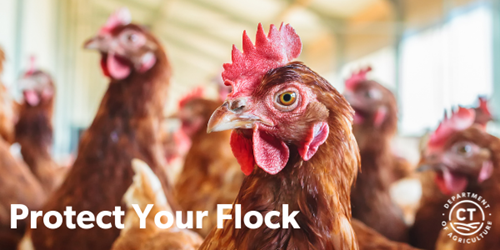Avian Influenza Information
Highly Pathogenic Avian Influenza (HPAI) Detections in Livestock

For more information regarding Highly Pathogenic Avian Influenza (HPAI) please follow the links below.
2022 Highly Pathogenic Avian Influenza (HPAI) Information
Avian Influenza FAQ Protect Your Birds From Avian Influenza
2022 Detections of Highly Pathogenic Avian Influenza
Found a Dead Wild Bird? Here’s What To Do Next
Avian influenza (AI) - commonly called “bird flu” - is an infection caused by influenza viruses that occur naturally in birds. Avian influenza viruses occur throughout the globe. Free-flying aquatic birds have been the most frequent source of virus: Ducks, geese, gulls, and shorebirds are considered principal reservoirs. In these species, AI infections usually do not cause signs of disease but have been incriminated as the source of many AI outbreaks in domestic poultry throughout the world.
Domesticated birds, including chickens, ducks, and turkeys, can also become infected. In the last five years, low pathogenic Avian Influenza has been found in Connecticut on three occasions. One strain of avian influenza, the H5N1 virus, is endemic in much of Asia and has recently spread into Europe. Avian H5N1 infections have recently killed poultry and other birds in a number of countries.
Strains of avian H5N1 influenza may infect various types of animals, including wild birds, pigs, and tigers. Genetic studies confirm that the influenza A virus H5N1 mutates rapidly. Should it adapt to allow easy human-to-human transmission, a pandemic could ensue – it has not done so to date. At this time, it is uncertain whether the currently circulating H5N1 virus will lead to a disease outbreak in humans.
Connecticut ranks first in New England for egg production and has a very diverse poultry industry. The discovery of AI in Connecticut can have serious economic, and possible public health consequences, and will require a rapid response to contain and eliminate the disease agent. The department has an emergency response plan that is constantly being updated, should Avian Influenza be discovered in Connecticut.
As part of our efforts to prevent the introduction of Avian Influenza into Connecticut poultry, the department conducts surveillance testing of birds throughout the state. Commercial and non-commercial flock owners are participating in our surveillance program. We have partnered with the Connecticut Veterinary Diagnostic Laboratory at the University of Connecticut to do low or no cost testing of birds for the Avian Influenza virus. We also have strict importation restrictions to prevent the spread of the virus in our state.
Bird owners need to be aware and report anything out of the ordinary. Anyone who may suspect poultry on their farm may have died from unknown causes should call the State Veterinarian at (860) 713-2505 or email ctstate.vet@ct.gov. Signs of Avian Influenza include depression, decreased feed and water consumption, decreased egg production, soft or misshapen eggs, and respiratory signs (coughing and sneezing). You can also find out more by visiting the Connecticut Department of Public Health's pandemic flu webpage or visit the USDA’s Bird Flu website.


